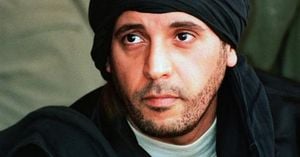For nearly two weeks, the disappearance of 23-year-old Kada Scott gripped Philadelphia, drawing in family, friends, and a city desperate for answers. On Saturday, October 18, 2025, a chilling breakthrough came: human remains were discovered in a shallow grave behind the abandoned Ada Lewis Middle School near Awbury Arboretum in Germantown. By the following day, a rapid DNA test brought the grim confirmation that many had feared—the remains belonged to Scott, the young woman last seen leaving her overnight shift at an assisted living facility in Chestnut Hill on October 4.
The discovery capped an intensive search that had spanned city neighborhoods, wooded parks, and the collective hopes of a community. According to FOX 29, the remains were found around 10 a.m. Saturday after police received a “very specific” anonymous tip. Officers had already combed the area days before, but the new information led them to the shallow grave, hidden in dense underbrush behind the vacant school. Investigators quickly cordoned off the scene, and by late afternoon, the remains had been removed for examination by the medical examiner’s office.
Deputy Commissioner John Stanford told reporters, “We are not going to confirm, at this point, that it is Kada Scott because that has to be done by the medical examiner’s office. There’s still a lot of work to be done.” But behind the scenes, police were already in communication with Scott’s family, preparing them for the likely outcome. By Sunday, the results from a rapid DNA test were in: a 99.9% match to samples from Scott’s parents. For the Scott family, and for the city, the search was over—but the questions had only begun.
Kada Scott’s disappearance had been marked by confusion and mounting dread from the start. According to Action News and AP, Scott arrived at The Terrace at Chestnut Hill, a senior-living facility, for her overnight shift around 10 p.m. on October 4. She wasn’t there long. Surveillance video was lacking in the parking lot, but records show Scott left the facility around 10:30 p.m., and her car—her mother’s—was found still parked at the site the next day. Her personal items, including her iPad, iPhone, and Apple Watch, were gone. Her parents called repeatedly, but the calls went straight to voicemail. “Whatever happened, she took her belongings with her,” her father, Kevin Scott, told NBC News.
When Scott failed to return home by the morning of October 5, her mother contacted the facility and received conflicting reports about her daughter’s whereabouts. The family met police at the nursing home, and a missing person’s report was filed. In the days that followed, police searched the Awbury Arboretum—one of the last places Scott’s phone had pinged before it was deactivated. The search, which included K9 units and eventually drew in the FBI and homicide detectives, turned up no immediate evidence.
The breakthrough finally came when officers found Scott’s debit card, phone case, and other personal items near the grounds of the abandoned Ada Lewis Middle School. This discovery, coupled with the anonymous tip, led investigators back to the school’s wooded perimeter, where they uncovered the shallow grave.
As the investigation unfolded, the focus quickly turned to Keon King, a 21-year-old from Southwest Philadelphia. According to FOX 29 and WPVI, King was the last known person to have been in contact with Scott on the night she vanished. Police arrested him last week, charging him with kidnapping, false imprisonment, stalking, and related offenses. His bail was set at $2.5 million, and he remains in custody awaiting a preliminary hearing in November.
King’s arrest has drawn renewed scrutiny of the justice system. As reported by AP and Action News, King had been charged earlier in 2025 in a similar case involving the alleged kidnapping and strangulation of another woman. In that incident, King was accused of abducting a woman outside her home, assaulting her, and eventually releasing her. Video evidence existed, but the case was dropped when the victim and a key witness failed to appear in court. King was released after posting 10% of a $200,000 bail—an outcome that now haunts city officials.
District Attorney Larry Krasner addressed the earlier case in a press conference, acknowledging, “We could have done better in that. A really sophisticated approach to the case would have been to try to put it all in with video evidence.” Krasner explained that the decision not to seek higher bail was a strategic one, influenced by the realities of late-night court procedures. “The unfortunate reality of this is that some, but not all of these judges, don’t want you calling them in the middle of the night. And if you do, they lower the bail. They don’t raise it, they don’t leave it. So it is always a complex, strategic decision.”
Not everyone agreed with the DA’s assessment. Marty O’Rourke, a spokesperson for the courts, responded, “With all due respect, the DA and his staff know there are assigned Municipal and Commons Pleas Court judges on call 24/7 and prepared at any hour to address emergency Court matters. In light of this truth, the DA’s comments are appallingly disrespectful and a sad attempt on his part to find a scapegoat for his own failings on this matter.”
Meanwhile, the Philadelphia City Council President Kenyatta Johnson spoke for many when he said he was “heartbroken and deeply disturbed” by the news of Scott’s fate. “Ms. Scott was a young woman with her whole life ahead of her—a Penn State graduate who had just begun her career in caregiving,” Johnson wrote in a statement. “The city must commit itself to protecting women and demanding accountability.”
For the Scott family, the heartbreak is personal and immeasurable. The investigation continues, with prosecutors reviewing new forensic evidence and preparing additional charges against King. The medical examiner’s office is expected to release more details about the cause of death in the coming days, and authorities urge anyone with information to contact police at 215-686-TIPS (8477).
As Philadelphia grapples with the aftermath of Kada Scott’s tragic end, the city’s leaders, law enforcement, and community members are left to reckon with the failures and hard lessons of this case—and to hope that justice, however delayed, will be served.





